March 29, 2023 – Volume 25, Issue 3
In This Issue
- Flanigan’s Eco-Logic: Oyster Bay, Long Island
- Nutritional and Ecological Values of Oysters
- Tesla Considering Heat Pumps
- High Speed Rail to Las Vegas
- Six Ways to Remove CO2 from the Atmosphere
- Flanigan’s Ego-Logic Podcast Updates
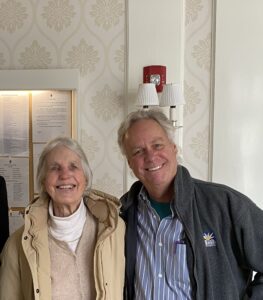
Flanigan’s Eco-Logic: Oyster Bay, Long Island
The small waterfront Village of Oyster Bay where I grew up, and where my mother lives, is known for at least three things: First, the oysters! Oyster Bay has a history of producing ~85% of New York State’s oyster harvest. Second, Oyster Bay was the Summer White House for, and is the final resting place of, U.S. President Theodore Roosevelt. Third: Billy Joel!
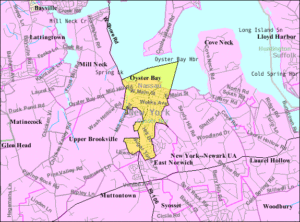
“Oyster” is the common name for a number of different families of salt-water bivalve molluscs. They live in brackish and saltwater bays like Oyster Bay, as well as estuaries, tidal creeks, shallow ocean areas, and intertidal zones. Most oysters, but not all, are in the family Ostreoidea. There are different oyster species: Atlantic, European Flat Oysters, Pacific Oysters including Blue Point, Shigoku, and Kumiai Oysters.
You know… people seem to love ‘em or hate ‘em, or are too nervous to try them! Yes, oysters certainly create an unusual sensation going down the hatch. Just the other night, my EcoMotion colleague Mark Hopkinson and I each had a dozen local oysters, each of us artfully dabbing them with fine blends of horseradish, cocktail sauce, and a vinegar concoction. Mom had the clams.
The next day, we head to the Oyster Bay waterfront, to the site of the old Jacobson’s Shipyard which serviced New York City tugboats when I was a kid. The big M on their side is etched in my memory and refers to Moran Marine Transportation and Harbor Services.
We were at the Waterfront Center to check out the restoration of the 50-foot oyster boat, the Ida May. It’s a community project led by our friend George Lindsay and the Christeen Oyster Sloop Preservation Corporation. Its mission is to preserve Oyster Bay’s marine heritage by involving the community in traditional boat building.
The Ida May is an historic oyster boat that plied the harbor here for 75 years, until 2003. It was one of the first oyster dredges to be powered by an engine. Prior to that, oyster men used sailing sloops to harvest oysters. Turns out the original Ida May, built in 1925, was too rotten to recondition.
Christeen, made up of a group of community leaders, have raised a million dollars for the construction of an exact replica of the Ida May. This includes a Billy Joel donation. Six professional shipwrights work every day on the Ida May, guiding teams of volunteers.

When launched this spring, the Ida May will be a floating classroom, a Coast Guard certified vessel able to take out 49 students at a time to dredge and harvest and to raise awareness about the role of oysters in local marine ecology and Oyster Bay’s maritime history. The Ida May is planned to launch on May 3.

It’s a good walk from our property to the cove, a small beach access where I launched my Laser for summer day sailing. This past month, the cold temperatures of February accented with snow flurries – had me walking briskly indeed, tracking my steps on my Oura. I am drawn to the water. Cold water, cold birds, boats out.

Theodore and Edith Roosevelts’ grave is just across from the cove, up on a hill overlooking his beloved Oyster Bay. I walked up to their grave site, to this day managed by my classmate Phil Roosevelt. I am once again struck by its simplicity. I am alone. There’s a fresh blanket of wet snow. The grave is humbly fenced and marked. I think of the man I’ve read so much about. I marvel at the serenity of these hallowed woods, a wonderful resting place.
One day I walk the extra miles to Sagamore Hill, Theodore Roosevelt’s home. I trek briskly along the winter water’s edge. Then up to Sagamore Hill which sits proudly on a hill; a spectacular promontory. The setting is complete with barns and a wind-powered water pumper. It’s a gray, overcast, New York day. Today the home and acreage is a National Historic Site managed by the National Park Service. I chat with a friendly ranger and use a posted qwerty code to get the more details.
The house was originally called “Leeholm,” named after TR’s first wife, and then later named Sagamore Hill. “Sagamore” is the Algonquin word for “chieftain, the head of the tribe.” The house was built in 1884 and then expanded in 1905. The addition includes the famous North Room, full of hunting trophies and gifts from foreign dignitaries.
The 26th president lived at Sagamore Hill for 30 years until his death in 1919. After his two-term presidency, and before embarking on his trip down the River of Doubt, Sagamore Hill is where TR went to lick his wounds after his humiliating presidential defeat to William Howard Taft in 1909. At Sagamore Hill, TR had his game room, wonderful forests and great views of the harbor… a path down to the beach.
Billy Joel is proud of his Oyster Bay roots… “From a town known as Wheeling, West Virginia…. From a town known as Oyster Bay, Long Island…” And the town is proud to have him live here. He now calls Oyster Bay home. And why not? He’s got his roots there and he can always fly a helicopter from his home on Centre Island in Oyster Bay to the roof of Madison Square Garden in New York City. That’s a venue he has sold out more than 70 times. He calls the Garden his “office.” Sound checks are done earlier by his longtime piano roadie. Billy Joel flies in, walks on stage, performs to wildly enthusiastic fans and great applause, and then helicopters home.
Billy Joel was born in the Bronx. He then moved out on Long Island and went to Hicksville High School. At his mother’s insistence, he took piano lessons. His teacher also taught ballet, and Joel would be ridiculed going to and from his lessons. Later he became a boxer to defend himself. He became a Golden Gloves amateur who won 22 bouts. Apparently he abandoned that after a broken nose in bout #24.
Billy Joel dropped out of high school and then made clear his direction to pursue music. “To hell with it. If I’m not going to Columbia University, I’m going to Columbia Records, and you don’t need a high school diploma over there.” He went on to become one of the best selling music artists of all time. He is the seventh best-selling recording artist and fourth best-selling solo artist in the United States with over 160 million records sold worldwide. And yes, he did get his high school diploma 25 years later.
He had huge hits in the 1970s and 1980s. Piano Man became his signature song. He went from being a solo artist to working with full rock bands. In 1987 he was one of the first artists to perform a concert tour in the Soviet Union following the country’s alleviation of the ban on rock music. He self-penned 33 Top 40 hits in the U.S., won six Grammy awards, and was inducted into the Rock and Roll Hall of Fame.
Quote of the Month
The IPCC’s sixth assessment “…makes for grim reading. Across nearly 8,000 pages, the AR6 details the devastating consequences of rising greenhouse gas emissions… and the irreversible risks should we fail to change course. But the IPCC also offers hope, highlighting pathways to avoid these intensifying risks. It identifies readily available, and in some cases, highly cost-effective actions…. While the window to address the climate crisis is rapidly closing, the IPCC affirms that we can still secure a safe, livable future.”
World Resources Institute Summary
IPCC’s 2023 Greenhouse Gas Assessment Report
Nutritional and Ecological Values of Oysters

For those that like eating oysters, there are hugely positive in terms of nutrition. They have few carbs, fewer fats, and lots of protein. They’re rich in vitamins and minerals, a good source of zinc, selenium, copper, iron and vitamin B12. Oysters have omega-3 fatty acids and antioxidants. They help manage body weight and blood sugar levels, reduce the risk of cardiovascular disease, improve sexual drive, and improve bone health.
Oysters also have tremendous ecological value. They are extraordinary water purifiers; they are extremely important in countering excesses in runoff of fertilizers and other organic wastes that cause algal blooms. Oysters are regarded as the “natural solution to pollution.”
A full-grown oyster can filter up to 50 gallons of water each day, a small bathtub’s worth! They feed by filtering water through their gills. Oysters in the Chesapeake Bay once could filter a volume of water equivalent to the entire Bay in a week. That’s 19 trillion gallons. Today it would take a year for the remaining oysters to do so.
Oysters capture algae and other microorganisms; they remove excess nitrogen and phosphorus and other pollutants. They have the ability to consume and then shape pollutants into small packets which are then deposited on the seafloor.
A number of factors have caused the alarming decline in oyster beds and populations: infringement on wetlands and marshes, increased pollution and erosion from developments, over-harvesting, and increased water temperatures. Oyster populations in the U.S. peaked in the late 1800s, they were commonly eaten by New York’s working class, but they declined in the 1900 due to overharvesting and disease. Many oysters were sickened by Perkinsus Marinus in the 1940s.

Oyster reefs are one of the most imperiled habitats in the world, with 85% of wild reefs lost over the past century. This speaks to the importance of regional efforts. New York’s Billion Oysters Project intends to engage one million people to restore one billion oysters in New York Harbor by 2035. Other initiatives involve educating the public and building new reefs and habitat using recycled shells, concrete, and crushed limestone.
Three closing notes and a timeline: Oysters are “sessile,” meaning that they stay in one place. Males sometimes become females. Female oysters release over 100 million eggs in a spawning event. Baby oysters, called “spat” grow into juveniles in one year, and adults in three years.
Tesla and Heat Pumps

Image Courtesy of Tesla
The third iteration of Tesla’s Master Plan was unveiled at the company’s Investor Day in early March. Master Plan 3 outlines a path to a fully sustainable future for for the Earth. It presents spheres of activity: electric vehicles, solar roofs and battery storage, and a fully sustainable Earth. It includes heat pumps.
Creating a sustainable energy civilization will take five steps: Re-powering the existing electrical grid with renewables; switching to electric vehicles, electrifying high temperature industrial chemical processes such as cement, steel, and fertilizers; Sustainable fueling plans and boats. Last but not least, is switching to heat pumps in homes, businesses, and industries.
Heat pumps are part of the plan. Elon Musk started by installing heat pumps in Model Y Teslas, then rolled the technology out to other models. Now Tesla is making waves by suggesting its entry into the heat pump business for homes. As our society decarbonizes, and makes power clean and local, heat pumps powered with solar systems pair nicely for carbon-free, heating and cooling.
According to ACHR News, a trade publication on air conditioning, heating, and refrigeration, heat pumps currently meet about 10% of building needs. The implementation of heat pumps is the lowest hanging fruit in terms of displacing fossil fuels. There’s a 50 – 75% reduction in the energy required to heat these buildings with a heart pump compared to a conventionally heating system.
High Speed Rail to Las Vegas

Image Courtesy of Brightline West
Taking a bullet train from Los Angeles to Las Vegas is now a step closer to reality. Its private sector developer, Brightline, announced that a trade agreement was reached on February 23rd with a coalition of major labor unions. Thirteen rail unions formed the High Speed Rail Labor Coalition in support of the project. The construction project will create 35,000 jobs.
The concept is elegant, using the medium of Interstate 15 for much of the rail route. Now that the labor agreement has been reached, the Brightline to Vegas project is slated to begin later this year and may be completed by 2027.
The new 218-mile rail system will be a $10 billion investment. Brightline plans to use existing Metrolink rail lines to go from Union Station in LA to Rancho Cucamonga. Then it will use new tracks to head to Vegas, with stops in Victor Valley, Hesperia, and Apple Valley. When construction is complete, the line will result in over 1,000 permanent jobs. Brightline boasts that it will be the most elegant travel by rail experience you can have in America. Further, it will be “the catalyst for America’s renaissance of travel by high-speed rail.”
The Brightline trains will run at speeds of up to 200 MPH. Currently there are more than 40 million one-way trips to Vegas each year by car or bus. Brightline’s target ridership is 12 million of those annually, the equivalent of removing 3 million vehicles and offsetting 400,000 tons of CO2 each year. And the rail service will relieve traffic on I-15… traffic that is notoriously bad on weekends. Brightline also plans to build three wildlife crossings to allow animals to safely cross the highway and railway.
Brightline is currently providing rail passenger service connecting Miami and Fort Lauderdale and West Palm Beach. The line features perks like Happy Hour Bloody Marys and ticket deals that include open bars.
Six Ways to Remove CO2 from the Atmosphere
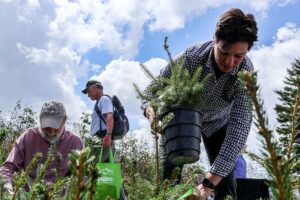
Several days ago, CleanTechnica – a recommended publication – presented an important article by the World Resources Institute (WRI). While there’s been lots of chatter about removing gaseous CO2 from the air, and direct carbon capture, WRI presents a range of sequestration strategies.
Since the Industrial Revolution, humans have put 2,000 gigatons of carbon dioxide into the global atmosphere. And more is emitted each year. The climate impacts will only intensify. The United States emitted 6 gigatons in 2021.
To stem the climate emergency, critical steps are being taken to fully adopt renewables, tap deep efficiency, stop deforestation, and curb the use of super-pollutants like HFCs. WRI states that, “The latest science tells us that these efforts alone are not enough… We need to not only reduce our emissions, but we’ve got to take some carbon out of the atmosphere and store it safely underground.” WRI presents six means of carbon dioxide removal:
#1 Trees and Forests: Plants sequester carbon through photosynthesis while giving us oxygen. We can boost this by restoring and managing tree cover; and by increasing the density of our forests. “Silvopasture” incorporates trees into animal agriculture. “Agroforestry” incorporates trees into row crop farming. Urban reforestation is about increasing the tree cover in cities. These are relatively low-cost carbon dioxide removal methods at ~$50/ton.
#2 Farms and Soils: Soils naturally sequester carbon. Since agricultural land covers 40% of America, small increases in sequestration rates can yield big results. Practices like frequent plowing and overgrazing causes soil erosion and can be stopped. Planting cover crops sequesters carbon; using compost helps plants develop deeper roots which results in greater carbon capture.
#3 Biomass Carbon Removal and Storage: Biomass carbon removal involves a range of processes to remove CO2 from the air, and then store it for long periods of time… well past the timeline of forestry practices. One example of this is the creation of biochar, a material made by heating biomass in low-oxygen environments. The product is a soil additive that boosts carbon sequestration. Other strategies are burying carbon-rich biomass in vaults, and converting biomass to hydrogen to capture and sequester carbon in the process.
#4 Direct Air Capture: Direct Air Capture (DAC) involves chemically scrubbing CO2 from the atmosphere… then sequestering the carbon underground or in long-lived products like concrete. Unlike capturing CO2 from power plants, direct air capture is not captured at the source. Thus it is an energy-intensive and expensive solution, in the range of $100 – 600/ton.
#5 Carbon Mineralization: Some minerals naturally react with carbon, turning CO2 gas into a solid. The process is known as “carbon mineralization” or “enhanced weathering. ” It happens naturally very slowly over hundreds and thousands of years. Can it be sped up? Could certain mine tailings be used to do so? Researchers are looking into crushing tailings, and developing enzymes that chew up mineral deposits… to increase their surface area and thus their ability to sequester carbon.
#6 Ocean-Based Approaches: The sixth means for CO2 capture is to leverage the oceans’ capacity to do so. This work is in its early stages of development, for example looking at ways to accelerate photosynthesis in coastal plants, seaweed, and phytoplankton. Researchers are analyzing adding minerals to seawater to react with dissolved CO2 and to lock it away, and how to promote coastal blue carbon that is stored in mangroves, seagrasses and salt marshes.
Flanigan’s Ego-Logic Podcast Updates
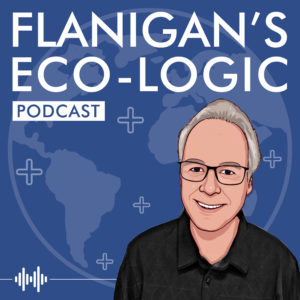
Use the links below to check out our recent podcasts. And you can always go to Spotify and type in “Ted Flanigan” to find our library of podcasts.
Recently Released:
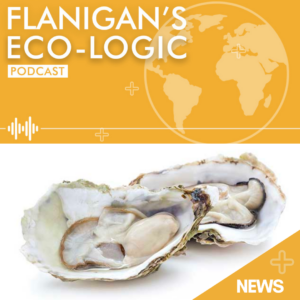
EcoNet News, Volume 25, Issue #3, features an essay on small waterfront Village of Oyster Bay where Ted grew up, highlighting three things it is known for: oysters, U.S. President Theodore Roosevelt, and Billy Joel. The issue also digs deeper into oysters, highlighting their nutritional and ecological value. Ted goes on to share stories on Elon Musk wanting Tesla to get into the heat pump business for homes, a bullet train from Los Angeles to Las Vegas becoming more of a reality, and six ways to remove CO2 from the atmosphere.

Karin Burns is the Chief Executive Officer of San Diego Community Power (SDCP), the 2nd largest CCA (Community Choice Aggregator) in California. The podcast covers her early life growing up in a small coastal New Jersey town, attending Duke University, and holding four additional degrees from esteemed universities. She also shares her experiences in traveling the world, beginning her professional career within the Finance and Capital industries, where she held several high-profile roles across Asia and the US, investing and fundraising in alternative energy, new media, and sustainability companies.
She served as Executive Director for Code REDD, an environmental company she built from a piece of paper into a globally recognized brand. She then became the Chief Executive Officer of Build It Green, where she oversaw a portfolio of energy efficiency programs across California, developed a low-income line of business, and fostered a culture of innovation and purpose-led growth. Karin later served as Regional Vice President for Franklin Energy Services LLC after executing an asset sale of Build It Green, guiding the cultural transition and integration of her company while managing five different Pacific states for Franklin Energy.
At SDCP, she is responsible for overseeing a $900+ million budget, a 30+ member staff, ensuring sufficient and reliable clean power procurement, as well as developing and executing the organization’s strategic plan in collaboration with the Board and staff. As an accomplished leader in the renewable energy sector, Karin is utilizing her diverse and broad experience to elevate SDCP to the apex of clean energy transitions, starting at the community level and expanding beyond. Karin is a dynamic innovator who seamlessly incorporates organizational efforts within humanity-focused strategy to affect change.

In this episode of Flanigan’s Eco-Logic, Ted speaks with Hunter Lovins, founder and President of Natural Capitalism Solutions (NCS). NCS helps companies, communities, and countries implement more regenerative practices profitably.
Hunter is a consultant to scores of industries and governments worldwide, and has briefed heads of state and leaders of hundreds of governments. Hunter is also the author of 16 books and hundreds of articles. She has won dozens of awards, including the Right Livelihood Award. Time Magazine recognized her as a Millennium Hero for the Planet, and Newsweek called her the Green Business Icon.
Her most recent book, A Finer Future: Creating an Economy in Service to Life won a Nautilus Award. Her areas of expertise include climate solutions, energy policy, regenerative agriculture, social enterprise, economic development, and sustainability.
She and Ted discuss ranching in Colorado, small-holder farming, and the circular economy of the soil. She notes that to feed a growing population, we need to restore soil quality, and ultimately reconcile farming systems with natural cycles.
She then delves into the concepts of “Natural Capitalism” and “Regenerative Economics,” highlighting that the future of capitalism will be built on intact community and adaptive values, with energy efficiency and renewable resources already driving prosperity.

James has been sailing since he was 4 years old. He has 37 years of experience in the renewable and energy-efficiency industry, having developed and managed over $140 million in energy-savings projects in the USA. He is a Certified Energy Manager and member of the Association of Energy Engineers. With a broad spectrum of lifetime accomplishments and innovations, James’ new frontier is to expand the benefits of renewable energy and electric propulsion to boat owners in California.
The podcast covers his early years and love for sailing, attending the University of Michigan to study Naval Architecture, and their shared experience of setting sail on the Ramblin’ Rose, a 40-foot sailing yacht powered by solar panels and electric propulsion. It’s one of the only vessels of its kind on the West Coast. The Ramblin’ Rose generates enough solar energy for instruments, auxiliary systems, cooking, and low-speed propulsion needed to get wind to sail.

Ralph Cavanagh is a senior attorney and co-director of Natural Resources Defense Council’s energy program. He joined the Natural Resources Defense Council in 1979 and has had an illustrious career focusing on removing barriers to cost-effective energy efficiency, and on the role that electric and natural gas utilities can play in leading a clean energy transition.
The podcast covers his studies at Yale College and the Yale Law School, and becoming a member of the U.S. Secretary of Energy’s Advisory Board (SEAB) from 1993 2003. The podcast digs deep into performance-based rate paying, revenue decoupling, NRDC’s stance on net-energy metering in California, and current decarbonization works.
Ralph has been a visiting professor at the Stanford and UC Berkeley Law Schools and a lecturer on law at Harvard, and he is a long-time faculty member at the University of Idaho’s Energy Executive Course. He chairs the advisory board of the Energy and Efficiency Institute at the University of California at Davis, and he serves on the boards of the Bipartisan Policy Center and BPC Action. He has received the Heinz Award for Public Policy, the BPA Administrator’s Award for Exceptional Public Service, the Alliance to Save Energy’s Charles H. Percy Award for Public Service, and the National Association of Regulatory Utility Commissioners’ Mary Kilmarx Award.
